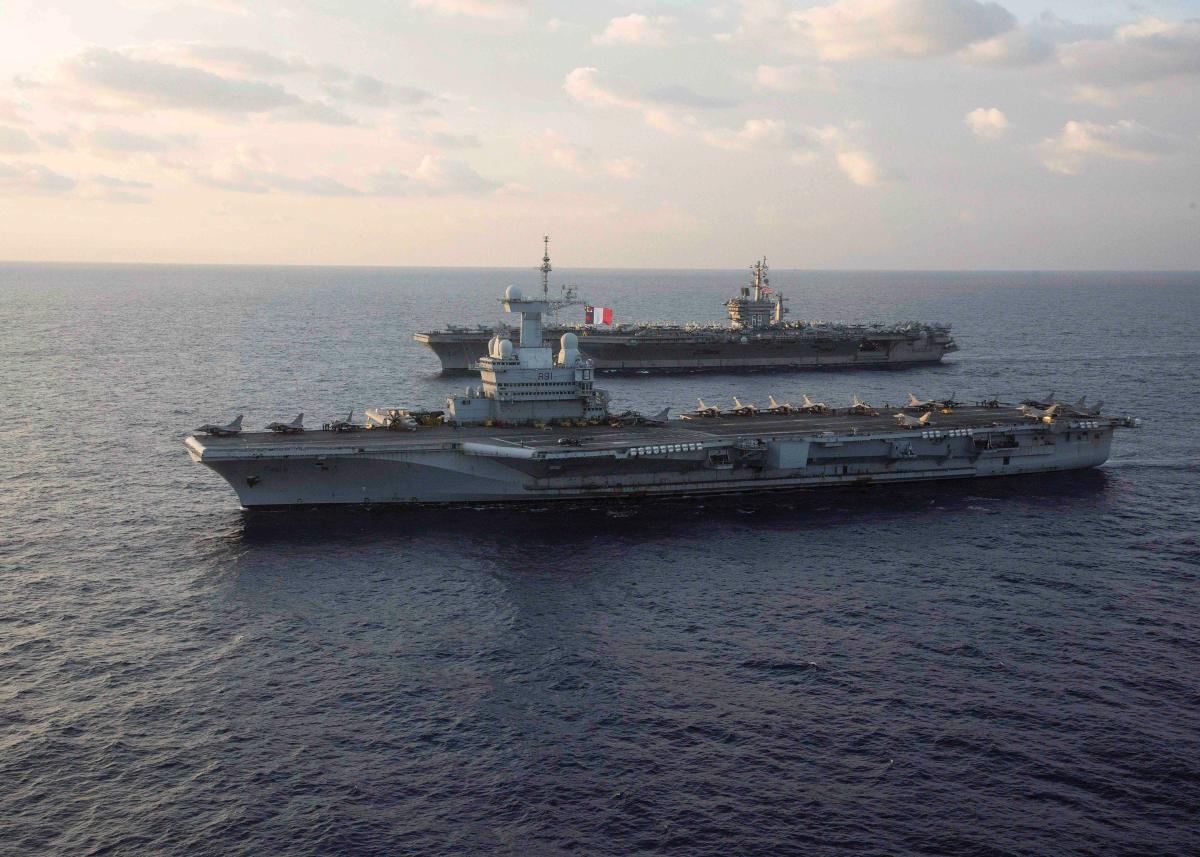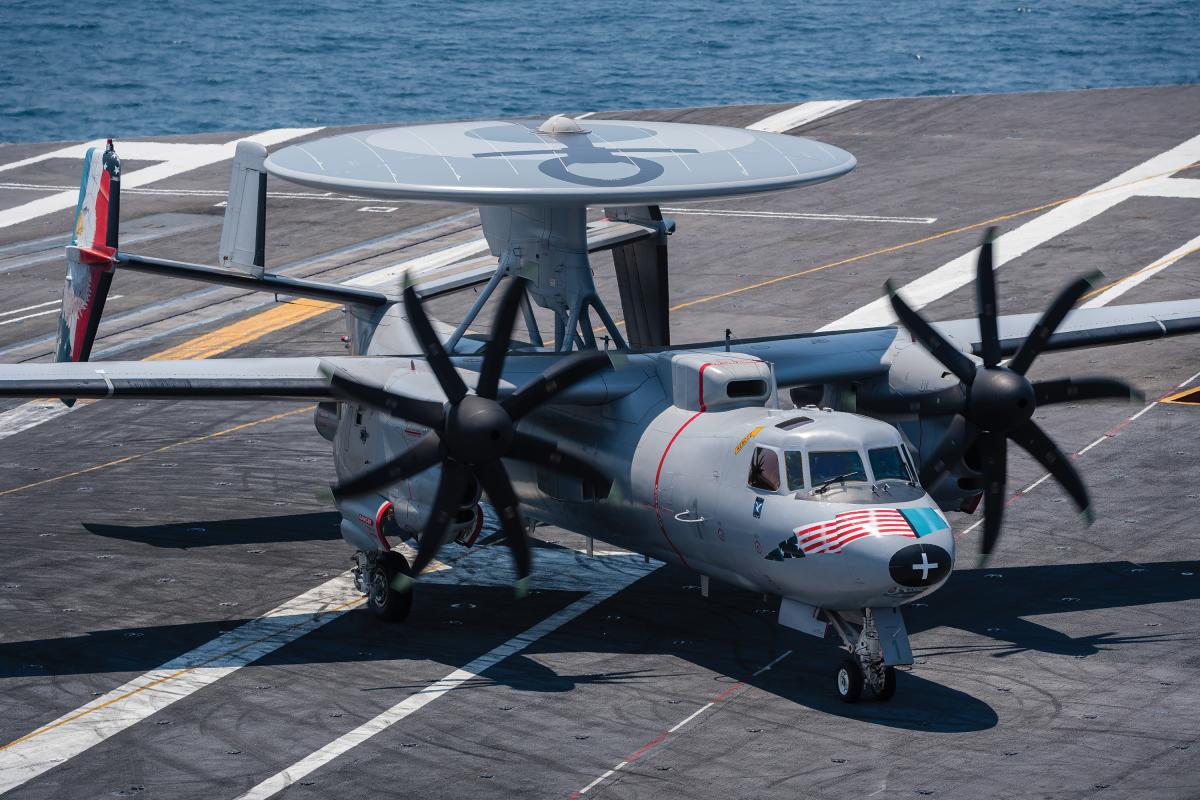The French nuclear-powered aircraft carrier (CVN) Charles de Gaulle is unique in every sense. It is the only European CVN, and its aviation facilities, weapon storage, combat system, and air wing combine with its seven escorts to create an extraordinary military capability—a carrier strike group (CSG). This capability can be decisive tactically, operationally, strategically, diplomatically, and politically. Its ability to deploy nuclear weapons adds an extra dimension.
But as the only one of its kind in Europe, the Charles de Gaulle leaves periodic gaps whenever extended maintenance periods keep it out of service. This happened with the just-completed midlife refit that began in early 2017. The upgrades constitute a major investment to fully meet the new challenges of a particularly unstable international environment.
Deployments
Since its first operational deployment in the wake of the terrorist attacks of September 11 2001, the Charles de Gaulle and its air wing have been almost continuously engaged. It supported operations in Afghanistan in 2001, 2002, 2004, 2006, 2007 and 2010; in Libya in 2011; in Iraq and Syria in 2015 and 2016. With more than 40,000 fighter sorties from its deck, its strike capability, and the intelligence collected with its sensors, the Charles de Gaulle CSG has contributed substantially to the protection of French nationals as well as to our country’s military and diplomatic interests.
Interoperability
If the CSG’s autonomous information-gathering and action capabilities get the most attention, the Charles de Gaulle’s interactivity with other ships and international partners also should be highlighted.
It contributes to joint intelligence missions and to airstrikes and fire support for ground units. Fully interoperable, it is integrated both on the ground and at high levels within coalitions, as part of NATO (Afghanistan) or multinational coalitions (Libya and the Levant)—and even under direct U.S. command in the Persian Gulf.
The mutual trust between the U.S. and French navies is so strong that the United States released command of its Task Force 50 CSG to the Commander, French Maritime Force, Rear Admiral René-Jean Crignola, during the Arromanches 2 deployment to the Gulf in December 2015. U.S. Chief of Naval Operations Admiral John Richardson considers our CSG ready for “plug-and-fight” with a U.S. CSG, within political limits, as demonstrated during the deployment of French fighters to Naval Air Station Oceana and on board the USS George H. W. Bush (CVN-77) in May 2018.
The French CSG also supports diplomacy and high-level political initiatives. German, British, Belgian, and Australian frigates participated in the Arromanches 2 and 3 missions to the Eastern Mediterranean in 2015 and 2016. Such activities add substance to our defense agreements and partnerships. The CSG assesses the strengths and vulnerabilities of the forces it encounters, pinpointing new interoperability requirements, and detecting weak points in the threats it evaluates.
The French Navy and the Ministry of the Armed Forces determine what areas need adjustment to strengthen the CSG’s military capabilities: the aircraft (Rafale fighters, E-2 airborne early warning airplanes, various helicopters, Atlantique 2 long-range maritime patrol craft, and drones); submarines; embarked commandos; mine-warfare assets; destroyers; and supply ships—as well as the aircraft carrier itself.
More Than Just a Midlife Upgrade
During its midlife overhaul, the Charles de Gaulle received major upgrades, which were identified during its many deployments, including the capability to operate farther away, more efficiently, and more forcefully. These capability upgrades, along with changes to the strike group, will enable it to meet the naval and military challenges of the next two decades.
The 2016 retirement of the Navy’s Dassault-Breguet Super Étendard fighters has meant the ship’s configuration required modification to accommodate the all-Rafale air wing. As the ship returns to the fleet, it now can embark up to 30 multirole jets with a substantially increased flight range compared to the former aircraft, and can deploy a wide range of airborne weapon systems.
Changes to the hangar spaces, weapon storage, and telecommunication systems will enable the ship to take the best advantage of the Dassault Rafale’s capabilities. Transitioning the aircraft to the future F3R standard will make it possible to arm the Rafale with the TALIOS pod (a long-range optronic targeting system) and the long-range air-to-air Meteor missile. The CSG’s power-projection capabilities will be enhanced, thanks to new Missile de Croisière Naval (MdCN) cruise missiles on board FREMM multimission frigates and Barracuda-class nuclear-powered submarines. These two new platforms will define the format of the future French Navy and its crews, strengthening our ability to defend our interests in the quiet, dark, and contested undersea world. The Atlantique 2 maritime patrol aircraft (Standard 6) will put France at the top of the leaderboard in the tactical and technological complexity of antisubmarine warfare, as the number and performance of submarines rapidly grow.
Our mine-warfare capabilities will be tailored to new threats. Technological progress will make possible development of new mine countermeasure platforms such as submersible and surface drones, as well as incorporation of new artificial intelligence–based concepts.
Beyond these key capabilities, in a less visible but nonetheless essential manner, we have undertaken other significant upgrades over the past decade. The upgrade to the Charles de Gaulle included a new radar, combat system, and very-high-speed network infrastructure to increase the flow of information as well as reinforce cyberdefense. The ship’s airborne early warning E-2 Hawkeyes are being upgraded as well, with plans to purchase the E-2D model in the next few years.
The Navy has commissioned Horizon-class and multirole FREMM frigates, both with improved air-defense systems. The intermediate-size Frégate de Défense et d’Intervention (FDI) in development will have a very promising watch system and significant data-processing capability. Our networks will need the ability to detect threats farther away and earlier to act offensively and defensively.
A range of new threats is emerging—hypersonic anti-ship missiles, supercavitation torpedoes, armed drones, and cyberattacks—requiring the CSG to operate at the highest level of self-defense vigilance. The vertically launched Aster missile family will become the new self-protection standard with the decommissioning of frigates equipped with Crotale EDIR and SM-1 missiles. But force-protection is conceived systematically, not ship-by-ship, and the Rafale fighters also will contribute to the defense of the CSG.
Finally, the CSG’s strategic mobility could not be ensured without adding a credible logistical support capability—the Flotte Logistique (FlotLog) program will deliver the first new replenishment ships by about 2025.
The Nuclear Naval Aviation Force (FANu)—built around the Charles de Gaulle and Air-Sol Moyenne Portée (ASMPA) nuclear-cruise-missile-equipped Rafale fighters—relies on all the CSG’s assets. It will be strengthened by upgrades to each component, as well as the ASMPA’s probable successor, the Air-Sol Nucléaire de 4e Génération (ASN4G).
But equipment, no matter how efficient or sophisticated, is not sufficient to make a military capability. During the Charles de Gaulle’s two-year operational hiatus, a major doctrinal revision was conducted, as well as significant training for the sailors affected by the upgrades. Our personnel are the real source of our tactical strength.
Formidable Operational Potential
Emboldened by the modernization of its major weapon systems and the integration of more powerful capabilities, the CSG must optimize its formidable operational potential. It also must take into account the increasingly competitive air and maritime environments and be prepared to counter a growing number of area-denial systems.
To that end, the long history of French naval aviation has laid a foundation on which the Navy, the Charles de Gaulle, its air wing, and its escort ships will base future combat tactics. For example, the FREMM frigates must develop new tactics to take advantage of the platform’s exceptional antisubmarine performance. The airwing must prepare for the growing threat from drones. And the CSG as a whole must learn to combine with great flexibility very diverse capabilities—of joint assets, other special forces, or allied navies—to respond to and better understand the ever-more-complex operational situation. In this way, the CSG will become a state-of-the-art combat system, constantly evolving and operated by sailors who master the use of their weapon systems, while flexibly adjusting to any environment.
Significant training took place on shore and on new ships during the aircraft carrier’s overhaul. Carrier- based sailors benefited from simulators during the refit, putting the crew in situations similar to those during operations at sea—including traditional as well as emerging threats such as cyberattacks, jamming, and malicious drones.
Now the sailors must put that training into effect in the real world as the Charles de Gaulle gets under way again. At sea, they will learn to combine the operational capabilities of the strike group through its tactical, carrier-based staff as well as those of allied navies.
Beyond operational readiness, logistical support is being mobilized not only for the ship but also to help the crew’s families. In that respect, to enable the embarked sailors to engage fully and with peace of mind in their mission, the Navy is working hard at reconciling the personal and professional expectations of the sailors. The first two FREMM frigates will experiment with dual crews from 2019 on, a new concept for the French Navy.
To meet the many challenges of today’s threat environment, the energy of many actors is required on many fronts—within the government, private industry, at the local level where naval and naval aviation bases are located, and among the sailors and their families.
Very few countries can mobilize the resources to set in motion and maintain the operational capability of a CSG. It is an honor for France to have achieved it.






